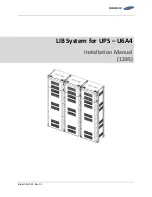
page 37 / 84
0MLMHTM30RUENUA
acceptable range. When the mains power supply is restored, the UPS is automatically reset to
Standby-Off
mode.
When operating in this mode the letter
F
will be displayed on the second line of the BASIC
MENU, near the UPS model.
5.7.4 Stabilizer mode (operation in on-line mode without battery)
Load is powered from the inverter, if there is a mains failure the load is not powered, the
batteries are not present.
Stabilizer mode:
This mode of operation makes the UPS a power conditioner with no backup capability. The
load is always powered through the inverter, with stabilized voltage and frequency, using the
energy from the input mains. The batteries are not present. In the event of an input mains
failure, the output of the STABILIZER is not powered.
In this mode the letter
S
is displayed on the second line of the BASIC MENU, near the UPS
model.
5.8
parameters setting
Using the CONTROL PANEL (from the basic menu press keys 3 and 5 and the access code 436215), the following
factory-set parameters can be modified within a limited range:
-
Language (see page 48 ),
-
value of the RATED OUTPUT VOLTAGE (see page 53 ) ,
-
BATTERY parameters (see page 53 ) ,
-
end of battery discharge pre-alarm (see page 54 ),
-
shutdown due to power lower than a set value (AUTO-OFF in power) (see page 56 ),
-
daily programmed shutdown (AUTO OFF time) (see page 56 ),
-
Frequency and voltage range on the BYPASS line (see page 57 ),
-
bypass frequency range (see page 57 ),
-
modem configuration (see page 57 ),
-
RS232-1 and RS232-2 ports (see page 58 ).
-
standby-on operation (see page 36 ),
-
Smart active operation (see page 59),
-
date and time (see page 62).
5.9
Procedure to transfer the load from UPS onto maintenance bypass (optional).
With several UPS connected in parallel, follow the procedure described in the section on “bypass for
maintenance” of chapter “Parallel version”.
There are two types of bypass switches: static switch and manual switch. The purpose of bypass is to provide a path for
power to flow from the bypass input to the load. The bypass path provides no conditioning of the power, so any
disturbance at the source will be present at the load. The reasons to use the bypass path include: failure of inverter,
overload of inverter, operating with low losses, and to allow maintenance operations on the UPS. If the UPS is part of a
parallel system, additional concerns and procedures regarding bypass apply. These issues are covered in Section
“Parallel”.
















































